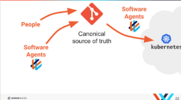Upgrade & Secure Your Future with DevOps, SRE, DevSecOps, MLOps!
We spend hours on Instagram and YouTube and waste money on coffee and fast food, but won’t spend 30 minutes a day learning skills to boost our careers.
Master in DevOps, SRE, DevSecOps & MLOps!
Learn from Guru Rajesh Kumar and double your salary in just one year.
Source:-devops.com
At a time when variations on DevOps abound, get ready for the latest: GitOps. This new term promises to bring some order to what can be operational chaos and empower operational teams to leverage best practices learned from their developer counterparts. It’s early days yet for GitOps, but here’s what we think you need to understand about this new facet of DevOps.
What is GitOps?
Everyone we spoke with has a slightly different perspective on GitOps, but this is our take: In its most basic form, GitOps is infrastructure and operational procedures defined as code, and living in a source control system, such as Git. Git becomes the single source of truth for what is running in production (or staging, or development).
Declarative systems, such as Terraform, AWS CloudFormation and Kubernetes help enable this practice; but operations is much more than Infrastructure as Code. True operations requires a way to plan, review and approve moves, adds and changes to the infrastructure. It also requires well documented procedures, or runbooks, to be successful. This is where GitOps differentiates itself. We believe GitOps is the full operations lifecycle of infrastructure management, living as code in a git repository.
GitOps may be used for managing both application deployments and base infrastructure made up of systems needed regardless of the applications deployed (i.e. networking, security, etc.). Both will follow the same procedures to plan, review, approve and release code into production. Done right, GitOps will let engineers constantly apply updates to infrastructure meet all the needs of the applications in a continuous delivery format. The version control system ensures everything is recorded and visible and an audit trail keeps teams compliant. GitOps will make it easy to revert problematic changes, becoming a single source of truth about what is happening in the system from both the software development and infrastructure perspective.
What Technology is Required?
In order to kick off GitOps, you’ll use a Git-based version control system. Then you’ll need the ability to create a declarative cloud infrastructure, using something such as Terraform and Kubernetes, with the help of Helm or Flux. Because both Terraform and Kubernetes are declarative systems, they make it simpler to create and deploy infrastructure as code in a manner that is both replicable and transparent. And you’ll also want to implement a solution such as GitLab that wraps operational procedures around these tools. GitLab, being an end-to-end DevOps solution can manage the backlog of requests, assign those requests to the appropriate subject matter expert to create the change in Git, facilitate the review and approval process, and kick off the execution of the changes using its flexible CI/CD system.
While it is possible to achieve this sort of workflow by using different solutions to merge and ship code to Kubernetes, GitLab is certainly a straightforward path to GitOps. It allows developers and operations administrators to work from the same source of truth and with a common set of procedures and tools.
What Are the Benefits?
In the DevOps world, GitOps is perhaps unique in that it can potentially benefit both operations team members and developers. For starters, GitOps aims to address the sometimes cave-like nature of operations (a single person working largely in isolation) by taking all of the best practices from software development and letting them loose on the deployment side.
Full oversight, architectural review, project management and all the other pieces of the process are brought together in GitOps in an effort to end ops versus everyone else and get all the stakeholders involved in the process. The basics don’t change–an ops engineer will still create an infrastructure–but that will just be one part of a much larger process that everyone can contribute to and collaborate on. No more worrying about an engineer creating a cloud infrastructure that can’t be replicated; with GitOps everything is tracked making repeatability easy. Suddenly it will also be simple to answer the “what changed?” question because no one will have to hunt for an answer. The bottom line is a successful GitOps program will benefit the actual bottom line because operational processes will be dramatically streamlined.
Possible Challenges
With any collaborative effort, change can be tricky and GitOps is no exception to that. It is usually easier to create one-offs and not follow a process, so the first thing to consider about GitOps is it will require discipline from all participants. It will be vital for teams to write everything down.
At GitLab we live and die by this thanks to our culture of collaboration, but we know it’s not necessarily something that comes naturally to any individual or organization. It will be vital for everyone on the team to record what’s going on in merge requests and issues. The temptation to edit something directly in production or change something manually is going to be difficult to suppress, but the less “cowboy engineering” the better GitOps will work.
If GitOps sounds like something your organization might benefit from, our best advice is to start small. Pick a tiny area to begin with, get a win and then build on that. At GitLab we call that iteration and it’s worked well for us.
